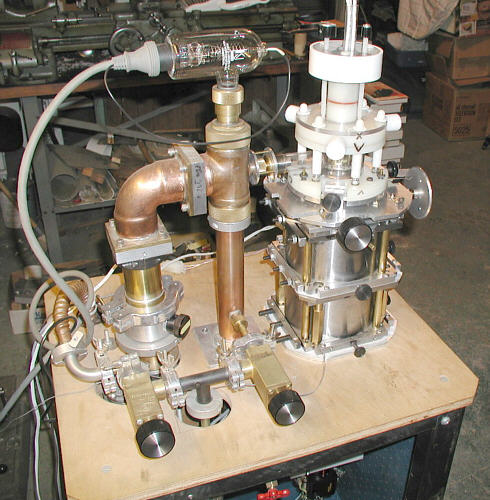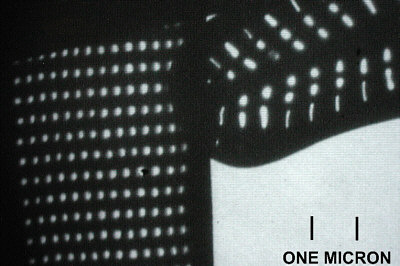|
by Robert Holzrichter, USA |
Editor's note: Robert recently contacted Micscape regarding his home-made TEM. We're sure readers will be fascinated with what the author has achieved, so the author has kindly allowed his e-mail notes and images to be presented on Micscape.
Robert's background as a professional electrical engineer with particular relevant experience, together with extensive private research over many years on TEM design, has uniquely enabled him to design and build a safe, working TEM at home.
However, few readers will have comparable expertise to undertake such a project, so this article is not encouraging any reader to build one. Only general construction concepts are described here out of interest and an early result shown. There are many potential dangers associated with building any apparatus using mains and higher voltages.
Robert writes (compiled by the Editor from e-mail correspondence):
I wondered if you would be interested in pictures of diatoms taken with a home-made transmission electron microscope.
Briefly, the microscope is a two stage design (objective lens and projector) followed by a CCD camera that views a fluorescent screen. The final image is viewed on a monitor that provides an additional x90 magnification. The video output is standard NTSC and can be recorded on an S-VHS recorder. Digital camera images are taken off the monitor screen.
By profession I am an electrical engineer, so the electronics was a lot of fun. On the other hand, the vacuum system has been an endless problem due to the many vacuum joints that can, and do leak. A recent vacuum problem was in one of the feed thru supports for the electron gun filament. Since it was a static seal, and had been working fine for months, I never suspected it. A cleaning, and new Viton O-rings fixed it. Pressure is now 1 x 10-5 torr, and the mechanical pump can remain off for half an hour before the pressure rises to 1 x 10-4 torr.
Alignment is much more difficult than I thought it would be. My controls are too coarse, so I'm adding reduction levers to the adjusting screws to produce the equivalent of 100 thread/inch adjustments.
In theory, right now the resolution should be better than 20 Angstroms. I don't have enough electron optical magnification to detect the 20 Angstrom spacings due to the limitations of the fluorescent screen, camera and monitor, but I should be able to see a 100 Angstrom resolution. Since it is actually no better than 200 Angstroms there are some serious problems waiting to be solved. No one said this was going to be easy!
The overall useful magnification range is about x4000 to x20000. At present, the resolution is about 20nm (200 Angstroms). I have just gotten the microscope operational this month.
Regarding the safety issues, although the voltage is high (30000volts), the current is low (30µA), and the amount of metal around the X-ray emitting area (electron gun) is adequate. Certainly warnings must be included. I worked in color television design many years ago and gained a healthy respect for high voltages.
Unfortunately, there are no finished designs out there just waiting to be built, only bits and pieces of information, in dozens of books, many going back to the 1930's and 40's. Actually, if it was easy, I wouldn't have wanted to do it.
Comments to the author Robert Holzrichter are welcomed.
Acknowledgement: The author thanks Klaus Kemp (UK) for supplying the diatoms.
(Editor's note: The author also sent an image of his extensive home library of books on TEM's and electron optics design.)
| A first image: The left-hand diatom
is Amphipleura pellucida. The right-hand diatom species is uncertain.
The finest optical microscope pushed to its limit can just resolve the dots of A. pellucida. See for example Will Varnell's images on Micscape using a Reichert Polyvar 100X plan-apo. |
Disclaimer:
As remarked above, this article is presented for interest and is not encouraging
readers to construct a TEM. Neither the author nor his employer, nor any
administrators of Microscopy-UK, Micscape, Onview.net assumes any responsibility
for damage to persons or property incurred by attempting to design and
construct an electron microscope.

